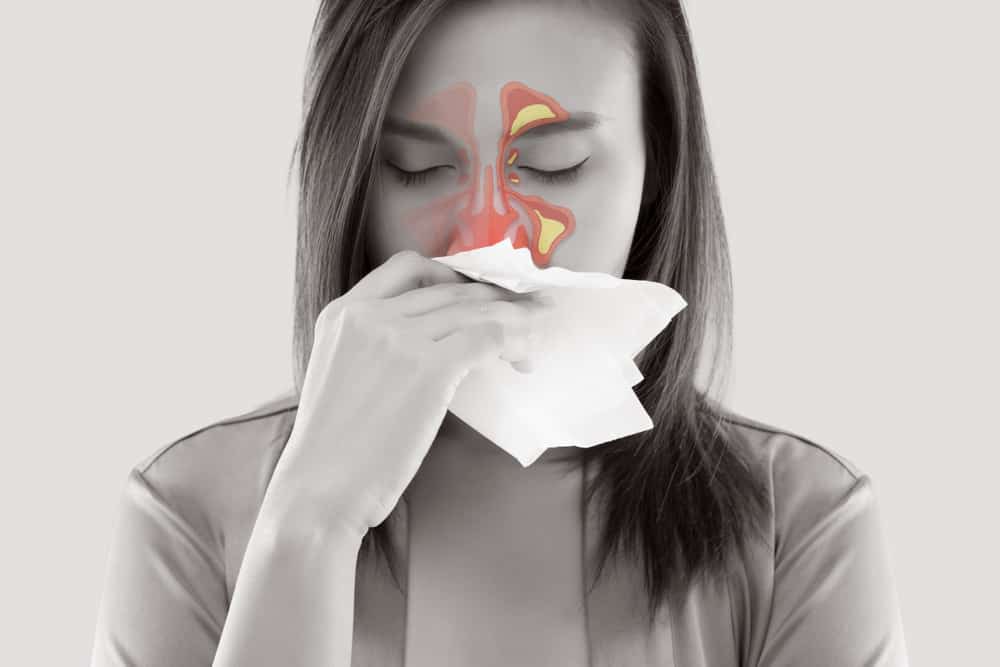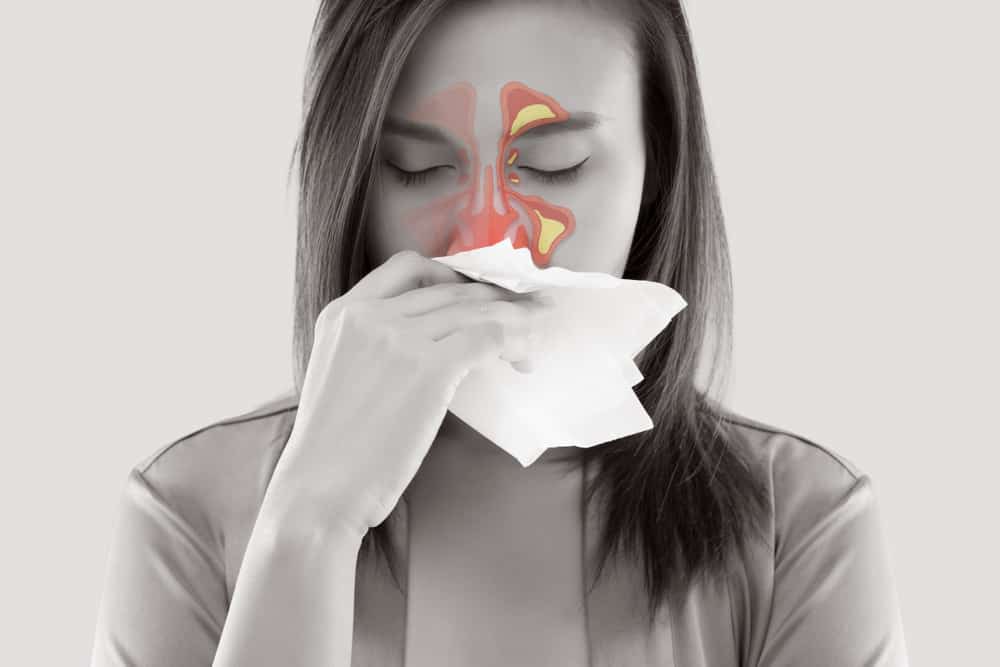Sinus Headache: Signs, Symptoms, and Treatment Options
November 4th, 2020 | 5 min. read


Around 70% to 80% of the population in the United States experience headaches, with 50% experiencing a minimum of one headache each month, 15% a minimum of one a week and 5% every day. The occurrence of headaches increases dramatically when you're in your 20s. After that it levels off until you reach between the age of 40 through 50 years old, after which it reduces.
What Is a Sinus Headache?
A sinus headache occurs when your sinus passages behind your nose, cheeks, eyes and forehead become congested. You can feel it on either side of your head or both at the same time. You'll not only experience pressure or pain in your head, but also anywhere in your sinus area. In some cases, a sinus headache is a symptom of the ongoing sinus condition called sinusitis.
A sinus headache can occur seasonally if you experience allergies, or only once in a while when something triggers your sinuses for some other reason.
What Does a Sinus Headache Feel Like?
When you experience sinus headaches, your face hurts. Usually, pain becomes worse when you suddenly move your head. Depending on the affected sinus, you might feel a continuous dull ache behind your eyes or in your:
- Forehead
- Cheekbones
- Bridge of your nose
What Are the Signs of a Sinus Headache?
Along with your common symptoms of facial pressure and pain and sinus and nasal congestion, it's likely you might experience symptoms associated with migraine, such as:
- Sensitivity to noise and/or light
- Nausea
- Throbbing pain and pulsing
- Moderate to severe headache
- Headache worsened by activity
Request an Appointment today with one of our houston ENT and Allergy Doctors
What Are the Sinus Headache Symptoms?
Sinus headaches might give you pressure and pain around your sinuses - in your forehead, particularly between and behind your eyes and above your nose. These areas might feel a bit tender to the touch. Pain may become worse with movement, such as lying down or bending over. If pain is the only symptom you experience, you likely aren't experiencing a sinus headache. Sinus headaches typically present other symptoms too, such as:
- Nasal discharge
- Stuffy nose
- Fatigue
- Sore throat
- Cough
Headaches and migraines from sinusitis are simple to confuse because the symptoms and signs of both could overlap.
Both sinusitis and migraine headache pain frequently becomes worse when bending forward. Migraine could also be accompanied by a variety of nasal symptoms and signs, including:
- Facial pressure
- Congestion
- Water, clear nasal discharge
This is because when you're experiencing a migraine attack, it involves the autonomic nervous system. In fact, research has shown that around 90% of individuals who see a physician for sinus headaches, actually are experiencing migraines instead.
However, sinusitis typically isn't linked with nausea or vomiting and isn't usually aggravated by bright light or noise which are all common migraine features.
Sinusitis typically occurs after a cold or upper respiratory infection and includes:
- Discolored, thick nasal mucus
- Pain in upper teeth or one cheek
- Decreased sense of smell
Headaches related to sinus disease frequently last for days, maybe longer and migraines typically last for hours; sometimes a day or two.
How Do You Get Rid of a Sinus Headache?
No doubt if you have a sinus headache you want to know how to relieve a sinus headache. Fortunately, many sinus infections will go away within seven to 10 days by themselves, just through the use of home remedies.
There are several things you can do from your home that might relieve your sinus headaches, including:
1. Spray
Use an OTC nasal decongestant spray containing salt water to help to:
- Unblock congestion
- Moisturize your nasal passages
- Treat inflammation
Certain sprays can only be used no more than a few days, such as Afrin. If you go past the three days, you could experience worse nasal congestion or "rebound." Other nasal sprays, such as fluticasone, are more efficient the more you use them.
2. Flush
Use a therapy that uses a water and salt solution, known as a Neti pot, to flush out your nasal passages. Using the Neti pot, nasal irrigation has been a proven treatment for sinus congestion for centuries. Many people swear by them and use them everyday or weekly to maintain good-flowing sinuses. When using a Neti pot, however, only use distilled water.
3. Hydrate
Make sure you drink plenty of fluids - juice and/or water - to help keep your mucus thin. Avoid beverages with alcohol or caffeine that can lead to dehydration.
4. Steam
Breathe in steam from a bowl or pot of warm water (not hot) or take a hot shower. Alternatively, you can place a wet, warm towel on your face and then follow up with a cool towel to help open your nasal passages and ease sinus pain.
5. Rest
Make sure you get plenty of rest which helps your body speed up recovery and fight infection. While sleeping, prop yourself up with a few pillows which will keep you elevated, helping you to breathe better.
6. Add Humidity
Use a vaporizer or humidifier in your room while you're sleeping to add moisture into your room's air and help decrease congestion. Certain things can aggravate your nose's mucus membranes, creating an environment attractive for sinus infection, such as:
- Tobacco smoke
- Dry air
- Chlorinated water
7. Over-the-Counter Medication
Take OTC antihistamines (if it's allergies), decongestants and pain relievers for reducing sinus pressure and pain. Be sure you speak with your doctor first if you're experiencing health problems or taking other medications. Never give OTC cold medicine or decongestants to kids under four years old. Nasal suction is the best way to "decongest" younger kids. This also decreases overall lung irritation and post-nasal drip.
What Are Sinus Headache Treatment Options?
When wanting to know how to treat a sinus headache, you're likely to begin by seeing your family physician, particularly if you’re experiencing chronic sinus headaches. They might refer you to a neurologist who specializes in migraines and headaches. Your physician might suggest treating the pain as well as the underlying causes of your sinus headache at the same time.
Some sinus headache treatment options include:
1. Triptans
Many individuals experiencing migraine attacks relieve the pain using triptans. Triptans promote constriction of blood vessels and block the brain's pain pathways.
Triptans include:
- Rizatriptan (Maxalt)
- Sumatriptan (Tosymra, Imitrex)
- Eletriptan (Relpax)
- Zolmitriptan (Zomig)
- Almotriptan, naratriptan (Amerge)
- Frovatriptan (Frova)
Triptans are available as nasal sprays, tablets and injections.
2. Ergots
Caffeine and ergotamine combination medications (Cafergot, Migergot) are not as effective as triptans. Ergots are typically the most effective in individuals experiencing pain lasts for over 72 hours.
3. Ergotamine
This might cause your migraine-related nausea and vomiting to become worse as well as other side effects. It might also cause medication-overuse headaches.
4. Dihydroergotamine (Migranal, D.H.E. 45)
This is an ergot derivative that's more efficient and doesn't have as many side effects as ergotamine. It comes in injection form and a nasal spray. This medicine is also not as likely to cause medication-overuse headaches.
5. Anti-Nausea Medications
Since nausea with or without vomiting often accompanies migraines, medicine for nausea is ideal and is typically combined with other medicines. Often prescribed medicines are metoclopramide (Reglan), chlorpromazine or prochlorperazine (Compazine).
6. Glucocorticoids (dexamethasone)
These might be used together with other medicines to enhance pain relief. Because of the steroid toxicity risk, glucocorticoids shouldn't be used often.
Request an Appointment for Sinus Headache Treatment at Houston ENT
If you feel pain or pressure around your sinuses, don't automatically think it's because you're experiencing a sinus headache. Carefully note your symptoms and pay attention for other symptoms and signs of a sinus infection, such as green nasal discharge or fever.
If your sinus pain doesn't go away, talk with our Houston ENT physician about the pressure behind your forehead, eyes or cheeks. They'll sit down with you and go over the different treatment options available that could help you find relief from any discomfort you're experiencing. Or, you can take advantage of our telemedicine appointments.
Topics:
